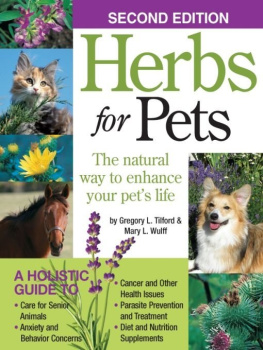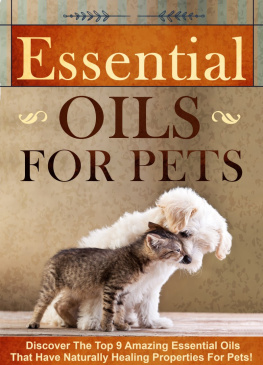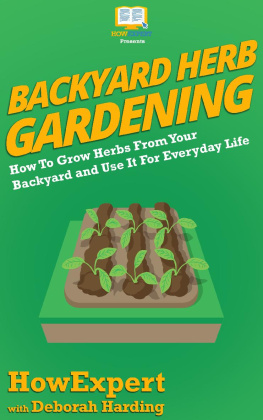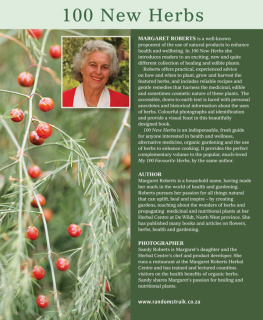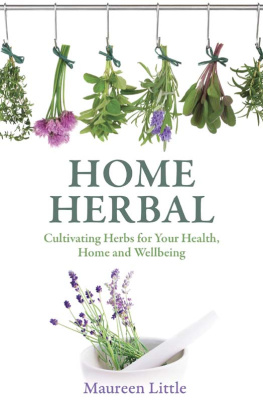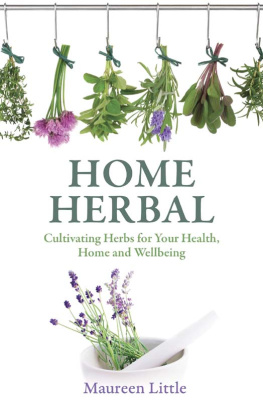Table of Contents
Acknowledgments
Its funny how a book takes on a life of its own. This one began like most othersfirst as a compilation of research, expressed knowledge, and the inspiration and ideas of an author or two. But now after many years have passed and many thousands of people have read, shared, used, and reflected on the content from its pages, this book has grown into something much moresomething far greater than anything I ever expected. For many, Herbs for Pets has become a gold standardthe definitive guide to herbs for pets. But it is not the authors, nor even the information contained in its pages, that stand at the forefront of this books resounding success. Its the growing audiences of pet loving people who are realizing that the biggest rewards of animal companionship can come only after we learn to accept and respect the true nature of our animals. Without people like you, this latest edition would not exist. Thank you.
And once againthank you to my now ex-wife and forever friend, Mary, who remains one of my foremost herbalist teachers. Thanks also go to Nancy Kerns, editor of Whole Dog Journal magazine, who throughout the years has been keeping the holistic word alive and visible to so many like-hearted animal lovers. And thanks to my dear friend Ikuko Kanada, who not only translated this tome into Japanese but also has been at the forefront of a new natural pet care revolution in Japan; your work brings renewed hope and inspiration to all who truly care about animal wellness. Thank you to Gail Pope and all of the incredible people at Brighthaven Sanctuarya place where, because of you, miracles really do happen.
A special thanks to all of you who came to our rescue when my home burned in the Montana fires of 2000. There is absolutely nothing to describe the feelings of love coming from so many people.
And of course, thank you to all of the wonderful holistic veterinarians and natural pet-care providers who work on the front lines to bring the gifts of human intellect, love, and compassion to the true innocents of the world: the animals.
Greg L. Tilford
I would like to thank and acknowledge my parents, George and Dixie Wulff for allowing me to be who I am and for letting Uncle Eldon give me my first puppy; Cindy Nicholls, a dear friend; Jan Newman, my cousin and friend: Jeanie Notti-Fullerton, a dear friend who shares a deep love and devotion for all creatures; to all of my animals past and present, for sharing their love and lives with me: Mister, Max, Mollie, Cedar, Willow, Stephanie, all gone but in my heart forever; Sage, the new Heeler in my life; Lili, the new cat in my life; and to Frog (the Doberman) and Kyra, the Shepherd; to my ex-husband, Greg, who made this book and many things possible, thank you for being a good friend.
Mary L. Wulff
Introduction
Herbs and animals have lived together for a long, long time. Millions of years before the first human walked the earth, creatures large and small were using plants as their primary source of healing. In fact, much of our modern medicine originates from what early humans learned through observation of wild animals and their instinctive uses of plants. For instance, we know that Indian tribes of the western United States learned of the powerful antimicrobial properties of Ligusticum porteri by observing bears ingest and roll in the plants to heal themselves. Even today, the plant is still known by many as bear medicine.
In the face of diseases such as AIDS and cancer, modern-day pharmaceutical researchers continue to scour the remaining wilds of our planet in search of cures, and once again we are turning to the animals for answers. Zoopharmacognosy, a new discipline of science that investigates how animals use plants to heal themselves, is attracting attention at leading research universities throughout the world. At the forefront of the zoopharmacognosy effort are Dr. Eloy Rodriguez, a biochemist specializing in natural products and synthetic chemistry, and Harvard primatologist Richard Wrangham, who has been studying chimpanzees and gorillas in their native African habitats. Rodriguez and Wrangham have discovered that the apes have an innate ability to select specific plant species for use against internal parasites. In fact, not only can the animals select plants that possess specific medicinal compounds that are effective at expelling their parasites but somehow they know exactly how much plant material is needed to initiate a cure without causing toxic side effects.
As zoopharmacognosy recaptures our attention and as our respect toward the healing wisdom of animals grows, our quest for herbal curative answers is becoming more urgent. But were faced with a problem. Strains of bacteria once thought to be conquered are reemerging despite our antibiotics, and healing resources are disappearing faster than we can discover them. Tens of thousands of acres of wild lands are lost each day to the effects of a growing human population and the relentless demands we place upon the planet. The Smithsonian Institution and fifteen other research organizations recently completed a twenty-year study that concluded that at least one in every eight plant species worldwide are currently at risk of becoming extinct.
In North America alone, it is estimated that 29 percent of sixteen thousand plant species are on the verge of disappearing foreverand with each loss, a vital connecting link between earth and all the creatures who walk her ground is being broken forever.
As scientists struggle to find cures before plants are eliminated from the face of the planet, a tremendous green revolution is under way. A growing number of people are coming to realize that much of the healing wisdom we seek rests not in science and technology but within the ancient healing traditions of nature itself. To access this awareness, we find ourselves turning to the aboriginal peoples (who adopted healing ways from observing animals) to relearn ways of healing that have been passed down through hundreds of generations from humankinds oldest teachersthe animals.
Ancient cultures knew that healthful living, healing, and good medicine are not gauged by how effectively people can exploit the medicinal properties of natural resources. Instead, shamans and medicine women of the past saw human health as an integral part of the living celestial body we have since grown to know as Earth. They knew that our gravest ills emanate not from what nature bestows upon us but from what we bestow upon nature. This message is being repeated to us everywhere in the form of ancient bacteria, once thought to be conquered, that are mutating into stronger, more resistant, more aggressive strains of infectious disease. Vaccines that we once viewed as miracle medicines are now thought to debilitate the immune system they were designed to support and protect. Heart disease, cancer, arthritis, osteoporosis, and even psychosis-driven murder are being linked to the stresses of modern society and the nutrition-depleted foods we eat. Violent rainstorms of unprecedented ferocity wreak havoc as a by-product of air pollution and the effects of global warming. You may ask, how is all of this relevant to a book about herbal animal care? The answer: in the most fundamental ways imaginable.
This book introduces you to hundreds of plant medicines that can be used in the daily care of animals. In the first chapters, you learn the importance of feeding your companion a natural whole-foods diet. Then step by step you are guided into new levels of self-reliance as you learn to select, prepare, and apply natural remedies, many of which may be as accessible as your own backyard, on behalf of your companion animal. To help overcome possible skepticism, we have provided references to hundreds of cutting-edge scientific studies that support the effectiveness of herbs in animals. But even more significant to the purposes of this book, we share what herbalists and animals have learned in the absence of science (without the cruel inhumanities of animal testing) from thousands of years of continuously safe and effective herb use.



